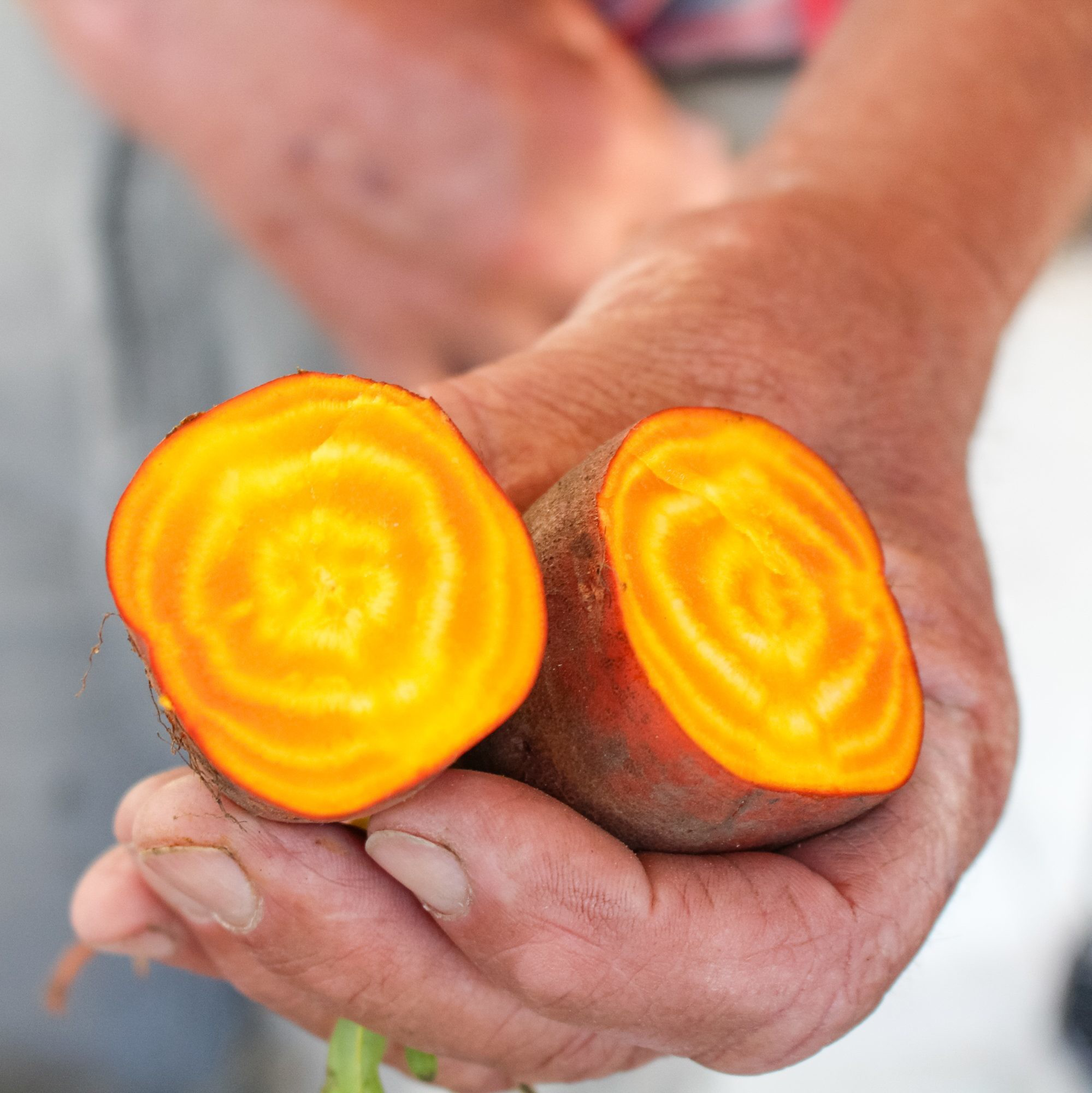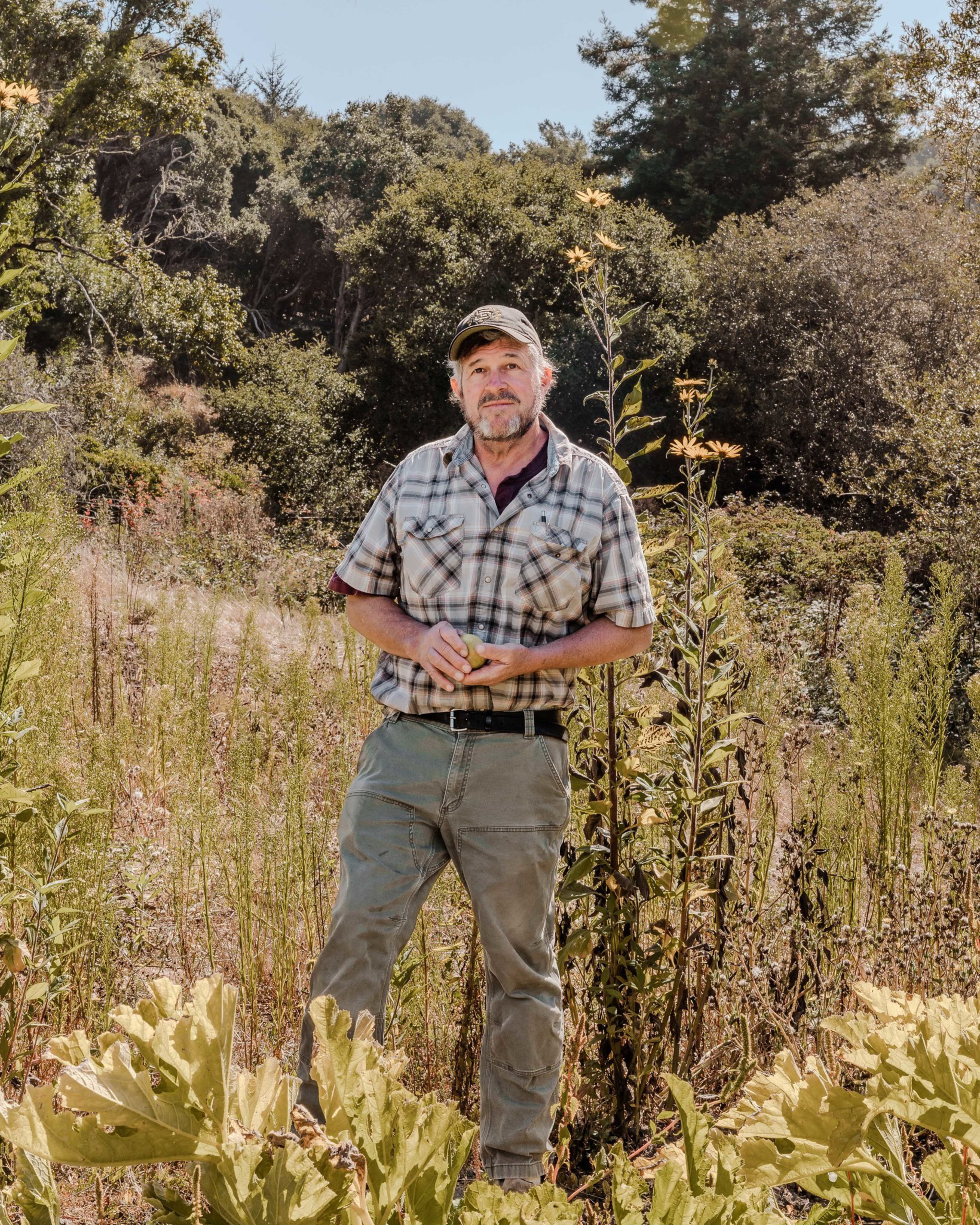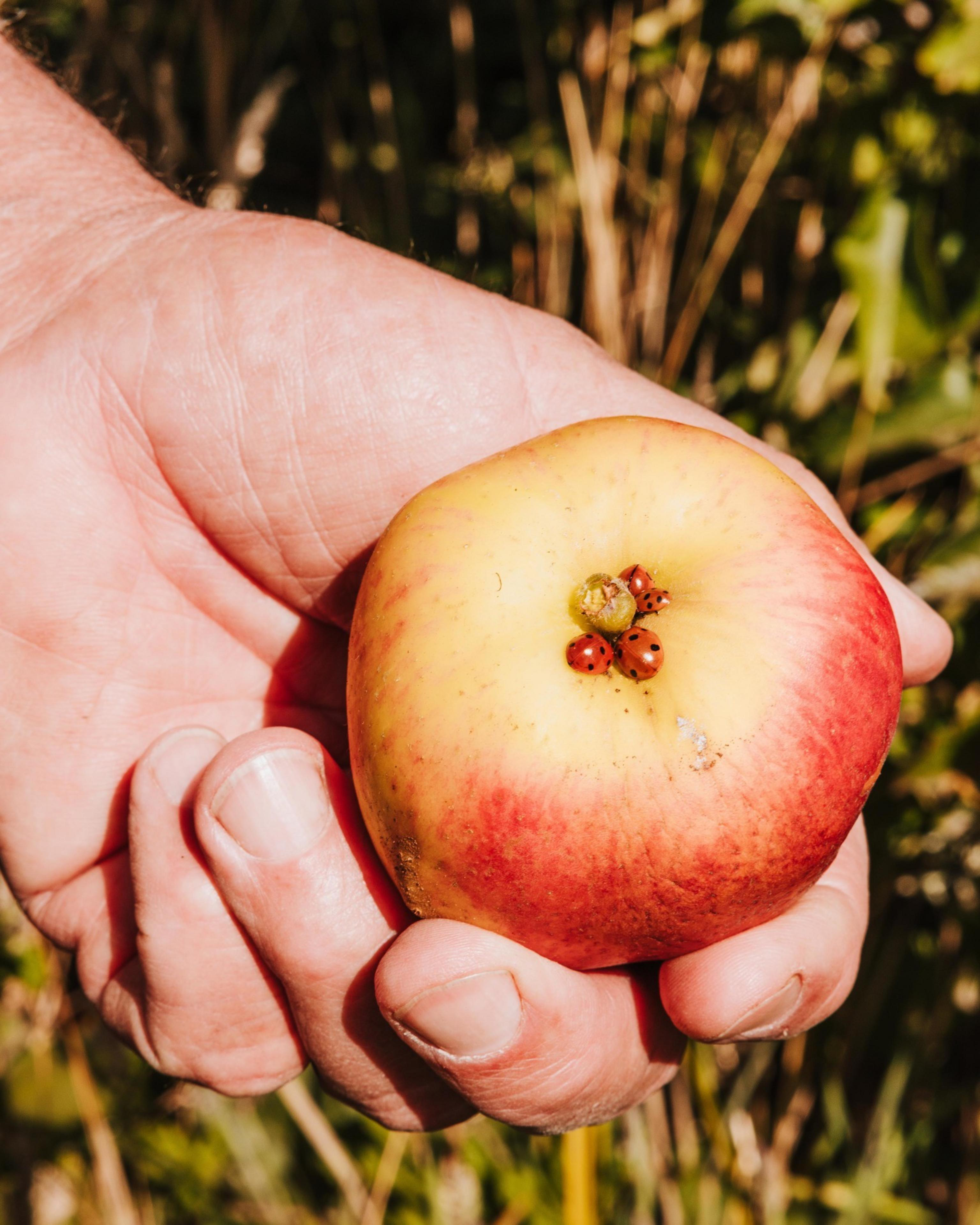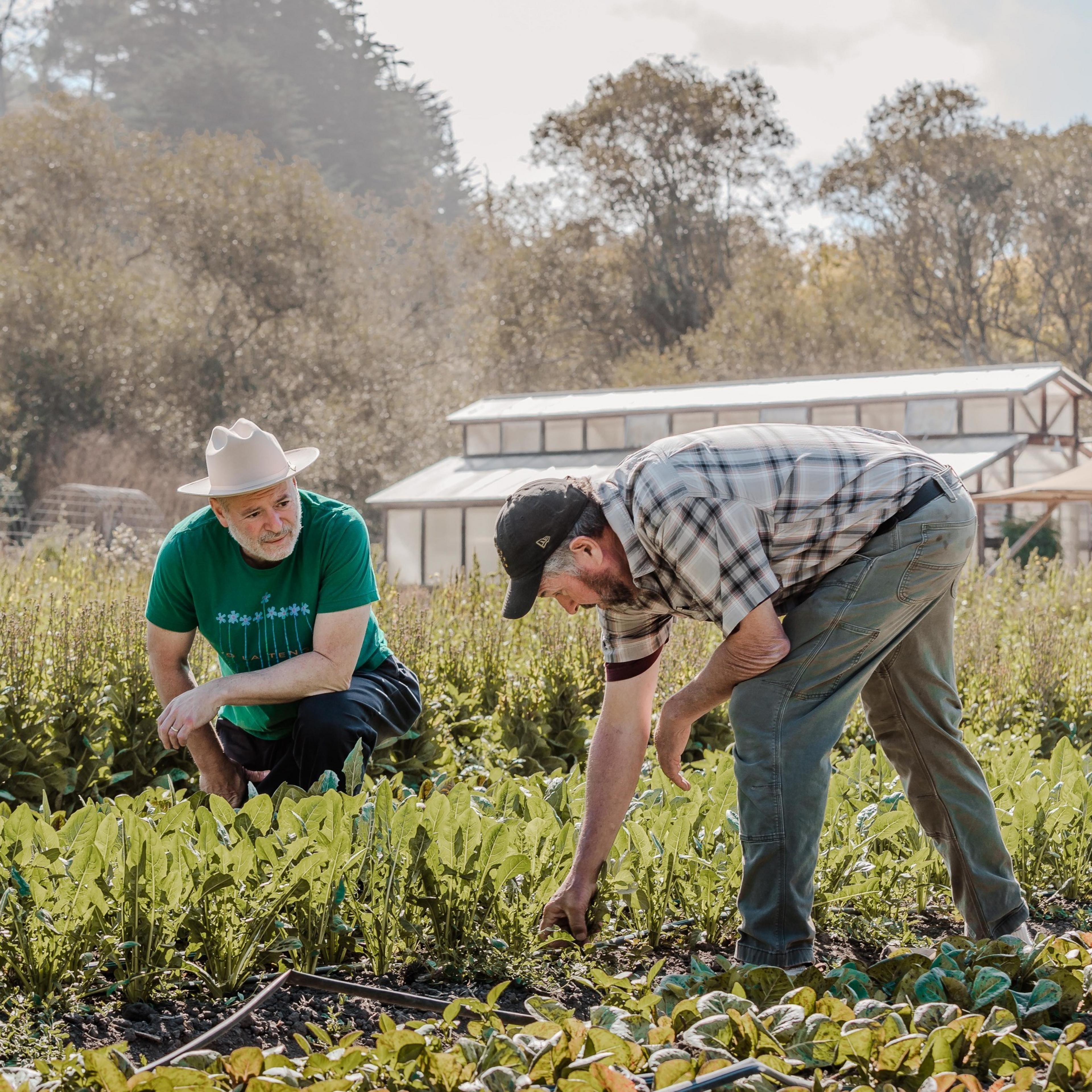It’s peak summer produce season at Fresh Run Farm, and Peter Martinelli is reveling in the abundance. The first-generation farmer is surrounded by stacks of crates holding the day’s harvest, everything from lustrous cherry tomatoes and tender strawberries to gangly haricots verts and delicate squash blossoms.
With sun-worn hands dusted in dirt, he extracts a bin from the Jenga block tower, plucks out a single vegetable, and cuts it in half with a knife produced from one of the pockets of his pants. Though it looks unremarkable on the outside, the interior of the Badger Flame beet is a work of tie-dyed art, with garnet flesh faceted with concentric saffron-colored circles.
Martinelli shaves off a thin slice and offers a taste. It’s earthy but staggeringly sweet, more like a carrot than a grocery store beet.


In a few short hours, the entire harvest will be some 30 miles away in the kitchen at Quince, one of San Francisco’s most celebrated restaurants. There, chef Michael Tusk and his team will transform Martinelli’s bounty into three-Michelin-star-worthy dishes, including “A Walk Through Fresh Run Farm,” a mosaic of beets, tomatoes, squash, lettuce, and tiny sprigs of herbs, all grown in West Marin and harvested earlier that day.
Even in a region that pretty much invented the farm-to-table restaurant, this kind of direct relationship between farm and kitchen is rare. Martinelli doesn’t just sell what he grows to Tusk and his wife Lindsay’s restaurants, which include Quince, Cotogna, and the soon-to-reopen Verjus. The farmer and the chef are business partners, with the former deciding what to plant based on what the latter wants to cook.
The restaurant pays for the seeds and the farm staff; the farm pays for the land and equipment. The symbiotic relationship benefits both businesses: Tusk doesn’t have to compete with other chefs for the best produce, and Martinelli doesn’t have to worry about making sales calls and deliveries to the city.
It’d be easy to romanticize the setup, but entwining a farm and a restaurant — and keeping the arrangement in place for nearly a decade — is incredibly difficult. Part of the challenge is that Fresh Run Farm is no made-for-Instagram culinary garden, operating almost as much for show as for function. “This is, like, a real working farm,” Tusk says.
Part of the magic of their partnership boils down to the shared ideals of local sourcing and responsible land stewardship — at times, above financial gain. “I think if you come at it in a very simplistic way, and you think that somehow you’re going to make money, or maybe break even, you probably won’t,” Martinelli says.


A bounty from ‘the floor of the coastal forest’
Getting to Fresh Run Farm from San Francisco requires driving over Mount Tam on two-lane roads that wind through shady redwood forests before dropping down to sea level in Bolinas, about an hour north of the city. The farm’s location in the mild West Marin climate means Martinelli can grow more than 40 varieties of fruits, vegetables, and flowers.
On a balmy late-summer afternoon, Martinelli walks the dirt paths that crisscross the property in a short-sleeved plaid button-up, a sun-bleached baseball hat perched on his head. He grew up in Bolinas but didn’t start Fresh Run Farm until 1995, after deciding he didn’t want to get into the family business.
“I was really being steered towards some kind of professional career, preferably law, and taking over the family practice here in the county,” Martinelli says. “I went as far as applying for law school and taking the LSATs, and then I realized that I was not cut out for that.” He’d already learned the fundamentals of growing food by tending to the backyard garden, and later spent a decade working at Star Route Farms (opens in new tab), located just up the road.
Fresh Run is one of the oldest certified organic farms on the West Coast and adheres to biodynamic farming practices. Martinelli’s a proud early acolyte of the organic movement and takes a bohemian approach to food production. “I don’t feel a farm should be a huge imposition on the natural environment,” he says, noting the “symphony of relationships” that underpin the farm’s productivity, including the wild yerba buena plants that “creep along the floor of the coastal forest.”


Neither Tusk nor Martinelli can recall exactly when they met, though the chef believes he’s been buying produce from Martinelli since the late ’90s. They do agree that the idea of forming a direct partnership came about thanks to a mutual friend, artist Madeleine Fitzpatrick (opens in new tab), in 2015.
They were hanging out at the stunning Marshall home (opens in new tab) Fitzpatrick shares with her husband, the salvaged wood seller Evan Shivley (opens in new tab). At the time, due to a yearslong drought, Martinelli was growing just four crops, including jack-o’-lanterns and potatoes, both of which could survive on scant winter rains. But Martinelli told Tusk he was getting ready to re-diversify production. By the 2016 growing season, Fresh Run Farm had become the farm of record for Tusk’s restaurants.
Tusk says the timing was fate. For the chef, Saturday morning farmers’ market runs were losing their luster. Meanwhile, Martinelli was tired of schlepping over the mountain to make deliveries. “I think it was just kind of meant to be,” Tusk says. “He wanted something different, I wanted something different, and until we tried it, we didn’t know if it was going to work.”


If you really want to know why it’s worth it for a single farm to supply a single restaurant group, you need to ask the farmer and the chef about dragon tongue beans.
As the story goes, Tusk was on a trip to Italy when he came across a dish of Italian shelling beans dressed in local olive oil and bottarga. They were delicious and eye-catching: white with bold purple streaks. He told the restaurant’s chef how much he loved them, and she gave him a bag of seeds, which he brought back to Martinelli. Now dragon tongue beans are a part of the farm’s regular crop rotation.
But there are downsides to this monogamous farming relationship, too. Once again, Martinelli points to those beans. “The first time we grew them, they’re super prolific, and I didn’t know that,” he says. He recalls the hundreds of pounds of harvest that drowned the kitchen in a tidal wave of legumes. “People were freaking out, like, ‘How many more dragon tongue beans are you gonna bring in?’ I was like, pickle them or do something — but stop complaining,” Tusk says.
‘People want a story’
There are, of course, other upsides to the relationship. For one, the restaurant’s staff sometimes goes up to Bolinas to taste strawberries just off the vine and help pull Martinelli’s dry-farmed potatoes out of the ground. These trips energize the team and give them a deeper connection to the food, which Tusk believes results in a better dining experience for customers.
Most importantly, Tusk says bringing a farm under the restaurant group’s umbrella feels like an organic extension of his cuisine and the restaurant’s identity. “This is definitely something that was natural,” he says. “And people want a story, you know? They don’t just want food on a plate.”


During peak season, Fresh Run Farm employs about five or six staff, plus Martinelli, who charges up the property’s gentle slopes with a slightly uneven gait. Though he still describes sitting on a tractor in the middle of a field as his “happy place,” health challenges have sidelined him for stretches of time over the past few years. He’s not sure what a succession plan for the farm might look like. Realistically, he says, when he retires, the farm will likely close.
The ephemeral nature of their relationship mirrors the delicate balancing act of farming — and of cooking. “Anything can shift the balance one way or the other, from the restaurant side or the farm,” Tusk says. “There’s so many factors that go into it, from both of us, in our lives and what’s happening.”
“With a partnership like this, a lot of it is the integrity of the players,” Martinelli agrees. “And, well, nothing goes on forever.”
